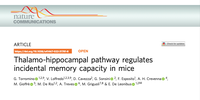Thalamo-hippocampal pathway regulates incidental memory capacity in mice
Incidental memory can be challenged by increasing either the retention delay or the memory load. The dorsal hippocampus (dHP) appears to help with both consolidation from short-term (STM) to long-term memory (LTM), and higher memory loads, but the mechanism is not fully understood. Here we find that female mice, despite having the same STM capacity of 6 objects and higher resistance to distraction in our different object recognition task (DOT), when tested over 1 h or 24 h delays appear to transfer to LTM only 4 objects, whereas male mice have an STM capacity of 6 objects in this task. In male mice the dHP shows greater activation (as measured by c-Fos expression), whereas female mice show greater activation of the ventral midline thalamus (VMT). Optogenetic inhibition of the VMT-dHP pathway during off-line memory consolidation enables 6-object LTM retention in females, while chemogenetic VMT-activation impairs it in males. Thus, removing or enhancing sub-cortical inhibitory control over the hippocampus leads to differences in incidental memory.

